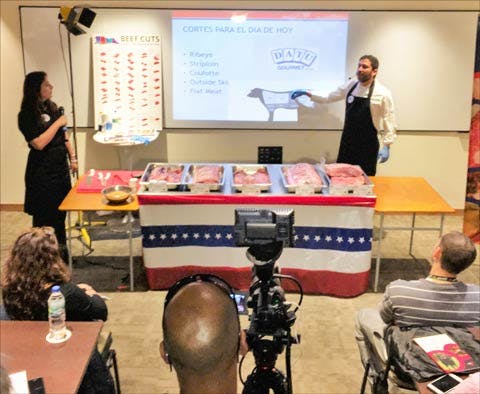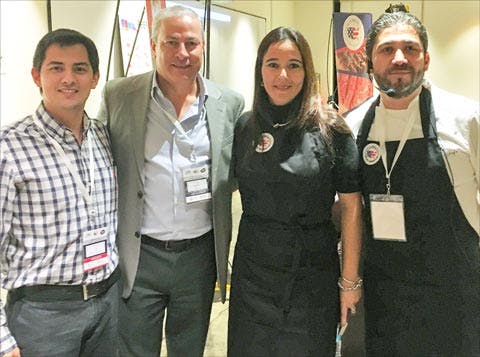U.S. Beef Training Targets Ecuador’s Foodservice Sector
USMEF conducted a U.S. beef training and cutting demonstration with Datu Gourmet, a major food importer in Quito, Ecuador. The effort, funded by the USDA Market Access Program (MAP), highlighted U.S. beef’s quality and new ideas on how to merchandise various U.S. beef cuts in the country’s hotels and restaurants.

U.S. beef was highlighted by Chef Miguel Angel Hurtado
Colombian Chef Miguel Angel Hurtado and Jessica Julca, USMEF representative in South America, led the training for 55 foodservice managers and staff. Diego Trujillo, general manager of Datu Gourmet, shared important details he learned on an Ecuadoran delegation that traveled to the U.S. earlier this year as part of the USDA’s Cochran Fellowship Program. During that September trip, Trujillo also attended the Americas Food and Beverage Show in Miami. He learned more about the U.S. beef industry and took new ideas back to Ecuador, where he introduced new cuts to the market – flap meat and coulotte – to go along with the ribeyes, striploins and outside skirts he already imported.
Trujillo said the Ecuadoran group that took part in the Cochran Program benefited greatly from the time it spent in the United States. The program, which provides training to farmers and other agriculture industry professionals from emerging markets, was organized through the University of Missouri. A visit to USMEF headquarters in Denver was part of this summer’s program.
USMEF is working to increase exports of U.S. beef to Ecuador, hoping to achieve the same kind of growth seen in Colombia, Peru and Chile. The U.S. industry is anxious to expand this success to Ecuador, but the market holds significant challenges.

(left to right) Pablo Londono, USMEF project assistant; Diego Trujillo, general manager of Datu Gourmet; Jessica Julca, USMEF representative in South America; and Chef Miguel Angel Hurtado
Ecuador was closed to U.S. beef for more than a decade following the 2003 BSE case. Exports to Ecuador resumed in the spring of 2014, but a year later the Ecuadoran government imposed a safeguard that added a 45 percent import surcharge to numerous food and consumer products, including beef and pork, from all exporting countries. For U.S. beef, the surcharge came on top of a 20 percent duty on muscle cuts and a 22.5 percent duty on variety meat.
Unlike Chile, Peru and Colombia, Ecuador has no free trade agreement with the United States. The import surcharges are under scrutiny by the World Trade Organization (WTO), but so far the WTO has allowed the surcharges to remain in place pending review. Ecuador recently lowered the surcharge on imported beef and pork from 45 percent to 30 percent, and has submitted a plan to the WTO that will drop the rate to 15 percent in April 2017 and to zero by June 2017.
In the meantime, the surcharges have adversely impacted exports to Ecuador. In 2014, beef/beef variety meat exports to Ecuador totaled 1,078 metric tons (mt) valued at $2.43 million, but in 2015 exports fell to 751 mt valued at $1.78 million. Through October, 2016 exports were 553 mt (-18 percent year-over-year) valued at $1.1 million (-30 percent). Pork exports in 2014 were 2,433 mt valued at $6.89 million. Last year exports increased slightly in volume (2,468 mt) but fell 15 percent (to $5.84 million) in value. Through October of this year, exports were 502 mt (-79 percent) valued at $1.25 million (-78 percent).

USMEF and Datu Gourmet partnered in a U.S. beef training and cutting demonstration in Quito, Ecuador
